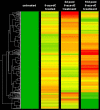Demethylation by 5-aza-2'-deoxycytidine in colorectal cancer cells targets genomic DNA whilst promoter CpG island methylation persists
- PMID: 20618997
- PMCID: PMC2912869
- DOI: 10.1186/1471-2407-10-366
Demethylation by 5-aza-2'-deoxycytidine in colorectal cancer cells targets genomic DNA whilst promoter CpG island methylation persists
Abstract
Background: DNA methylation and histone acetylation are epigenetic modifications that act as regulators of gene expression. Aberrant epigenetic gene silencing in tumours is a frequent event, yet the factors which dictate which genes are targeted for inactivation are unknown. DNA methylation and histone acetylation can be modified with the chemical agents 5-aza-2'-deoxycytidine (5-aza-dC) and Trichostatin A (TSA) respectively. The aim of this study was to analyse de-methylation and re-methylation and its affect on gene expression in colorectal cancer cell lines treated with 5-aza-dC alone and in combination with TSA. We also sought to identify methylation patterns associated with long term reactivation of previously silenced genes.
Method: Colorectal cancer cell lines were treated with 5-aza-dC, with and without TSA, to analyse global methylation decreases by High Performance Liquid Chromatography (HPLC). Re-methylation was observed with removal of drug treatments. Expression arrays identified silenced genes with differing patterns of expression after treatment, such as short term reactivation or long term reactivation. Sodium bisulfite sequencing was performed on the CpG island associated with these genes and expression was verified with real time PCR.
Results: Treatment with 5-aza-dC was found to affect genomic methylation and to a lesser extent gene specific methylation. Reactivated genes which remained expressed 10 days post 5-aza-dC treatment featured hypomethylated CpG sites adjacent to the transcription start site (TSS). In contrast, genes with uniformly hypermethylated CpG islands were only temporarily reactivated.
Conclusion: These results imply that 5-aza-dC induces strong de-methylation of the genome and initiates reactivation of transcriptionally inactive genes, but this does not require gene associated CpG island de-methylation to occur. In addition, for three of our selected genes, hypomethylation at the TSS of an epigenetically silenced gene is associated with the long term reversion of gene expression level brought about by alterations in the epigenetic status following 5-aza-dC treatment.
Figures



Similar articles
-
Promoter histone H3 lysine 9 di-methylation is associated with DNA methylation and aberrant expression of p16 in gastric cancer cells.Oncol Rep. 2009 Nov;22(5):1221-7. doi: 10.3892/or_00000558. Oncol Rep. 2009. PMID: 19787243
-
Long term transcriptional reactivation of epigenetically silenced genes in colorectal cancer cells requires DNA hypomethylation and histone acetylation.PLoS One. 2011;6(8):e23127. doi: 10.1371/journal.pone.0023127. Epub 2011 Aug 4. PLoS One. 2011. PMID: 21829702 Free PMC article.
-
Epigenetic silencing of maspin expression occurs early in the conversion of keratocytes to fibroblasts.Exp Eye Res. 2008 Apr;86(4):586-600. doi: 10.1016/j.exer.2008.01.003. Epub 2008 Jan 12. Exp Eye Res. 2008. PMID: 18291368 Free PMC article.
-
Epigenetic DNA-(cytosine-5-carbon) modifications: 5-aza-2'-deoxycytidine and DNA-demethylation.Biochemistry (Mosc). 2009 Jun;74(6):613-9. doi: 10.1134/s0006297909060042. Biochemistry (Mosc). 2009. PMID: 19645665 Review.
-
Reactivation of silenced genes and transcriptional therapy.Cytogenet Genome Res. 2003;100(1-4):56-64. doi: 10.1159/000072838. Cytogenet Genome Res. 2003. PMID: 14526164 Review.
Cited by
-
DNA methyltransferase inhibitors improve the effect of chemotherapeutic agents in SW48 and HT-29 colorectal cancer cells.PLoS One. 2014 Mar 27;9(3):e92305. doi: 10.1371/journal.pone.0092305. eCollection 2014. PLoS One. 2014. PMID: 24676085 Free PMC article.
-
Effect of 5-aza-2'-deoxycytidine on p27Kip1, p21Cip1/Waf1/Sdi1, p57Kip2, and DNA methyltransferase 1 Genes Expression, Cell Growth Inhibition and Apoptosis Induction in Colon Cancer SW 480 and SW 948 Cell Lines.Galen Med J. 2020 Dec 26;9:e1899. doi: 10.31661/gmj.v9i0.1899. eCollection 2020. Galen Med J. 2020. PMID: 34466608 Free PMC article.
-
Targeting microRNAs: a new action mechanism of natural compounds.Oncotarget. 2017 Feb 28;8(9):15961-15970. doi: 10.18632/oncotarget.14392. Oncotarget. 2017. PMID: 28052018 Free PMC article. Review.
-
Molecular Pathogenesis of Colorectal Cancer: Impact of Oncogenic Targets Regulated by Tumor Suppressive miR-139-3p.Int J Mol Sci. 2022 Oct 1;23(19):11616. doi: 10.3390/ijms231911616. Int J Mol Sci. 2022. PMID: 36232922 Free PMC article.
-
Antenna-enhanced mid-infrared detection of extracellular vesicles derived from human cancer cell cultures.J Nanobiotechnology. 2022 Dec 13;20(1):530. doi: 10.1186/s12951-022-01693-2. J Nanobiotechnology. 2022. PMID: 36514065 Free PMC article.
References
Publication types
MeSH terms
Substances
LinkOut - more resources
Full Text Sources
Medical
Research Materials

